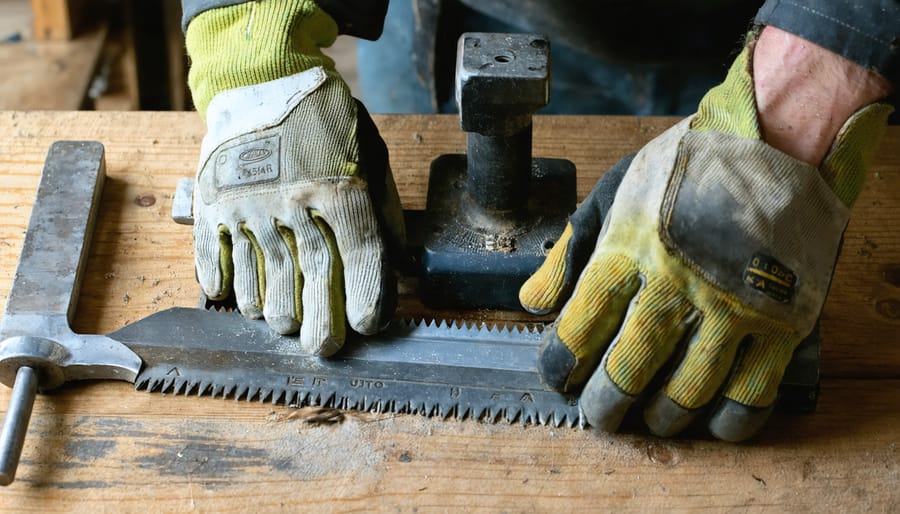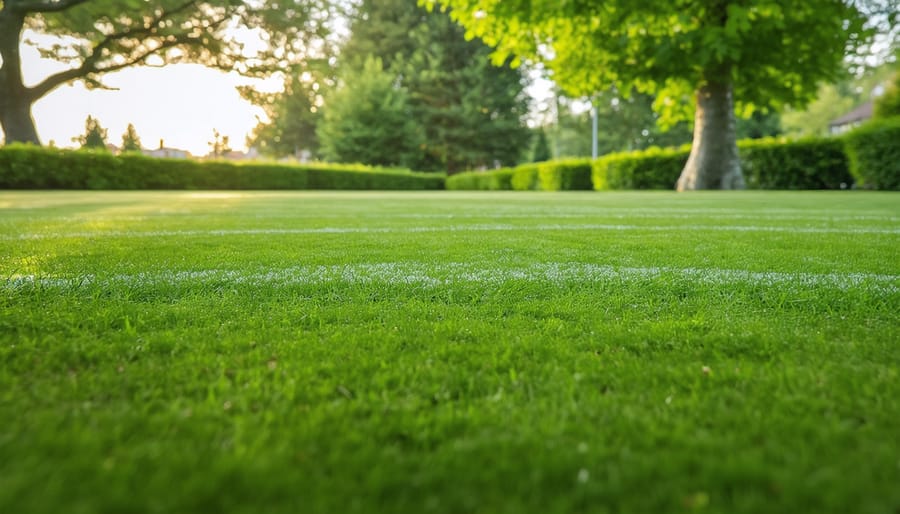Restore your mower’s cutting power with precision manual blade sharpening – a sustainable, cost-effective approach to basic mower blade maintenance. Using just a bench vise, metal file, and protective gear, transform dull, inefficient blades into razor-sharp cutting edges that deliver clean, healthy grass cuts. Manual sharpening not only extends blade life but also prevents the brown, torn grass tips that result from dull blades, while giving you complete control over the sharpening angle and pressure. Unlike power tools, this traditional method reduces the risk of removing too much metal or compromising the blade’s crucial balance. Master this essential skill to maintain your mower’s performance throughout the growing season, save money on replacement blades, and achieve that pristine, professionally manicured lawn appearance every time you mow.
Essential Manual Blade Sharpening Tools
Basic Sharpening Equipment
To get started with manual blade sharpening, you’ll need a few basic yet essential tools. A quality mill bastard file (10-12 inches long) is the most versatile option, offering good control and consistent results. This traditional tool features diagonal teeth that help maintain the correct cutting angle on your mower blade.
A sharpening stone or whetstone provides another effective option, particularly for fine-tuning the edge. Choose between coarse (around 400 grit) and fine (1000+ grit) stones, with the coarse stone handling initial sharpening and the fine stone providing the finishing touches.
Purpose-made manual blade sharpeners are also available, featuring preset angles and guide slots that help maintain consistency. These tools often come with comfortable handles and safety guards, making them particularly suitable for beginners.
Additional essential items include a wire brush for cleaning the blade, protective gloves, and safety glasses. A bench vise or C-clamps will help secure the blade while you work, ensuring both safety and precision. Remember to keep your sharpening tools clean and dry between uses to prevent rust and maintain their effectiveness.
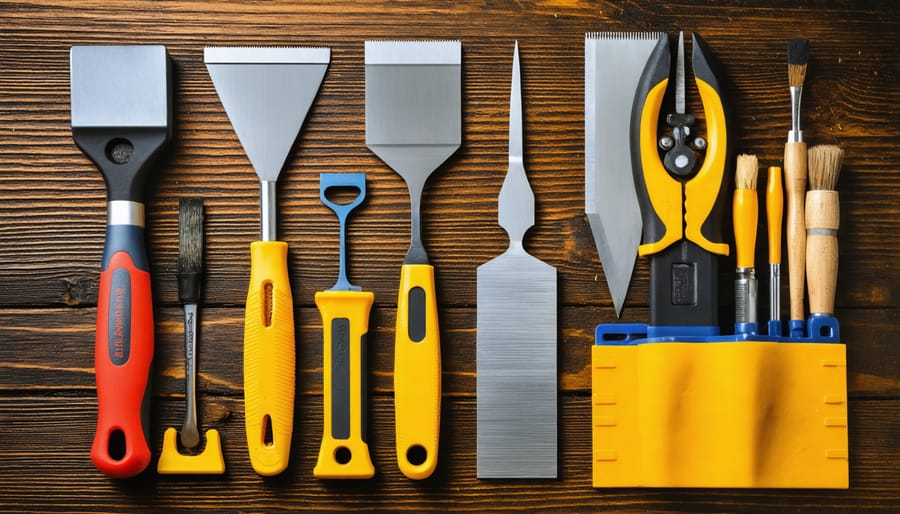
Safety Gear and Workspace Setup
Before you begin sharpening your mower blade, setting up a safe workspace and wearing proper protective gear is essential. Start by choosing a well-lit, flat surface in your garage or workshop. Clear the area of any unnecessary items and ensure you have enough room to work comfortably.
For personal protection, always wear safety goggles to shield your eyes from metal shavings. Thick work gloves are crucial to protect your hands from sharp edges and prevent cuts. Steel-toed boots provide additional protection in case you accidentally drop the blade.
Organize your workspace by laying out a clean tarp or workbench mat. This makes it easier to spot small metal particles and keeps your work area tidy. Have a sturdy vise ready to firmly hold the blade while you work. Keep your sharpening tools within easy reach but organized to prevent accidents.
Remember to work in a well-ventilated area, as metal shavings can become airborne. If working indoors, consider wearing a dust mask. Keep a first aid kit nearby, just in case, and ensure your workspace is away from children and pets.
Preparing Your Mower Blade for Sharpening
Safe Blade Removal Steps
Before attempting any blade maintenance, it’s crucial to follow proper safety protocols. Start by working in a well-lit area and wearing thick work gloves to protect your hands. Always disconnect the spark plug wire to prevent accidental startup – this is an absolute must for your safety.
Tip your mower onto its side, ensuring the carburetor and air filter are facing upward to prevent oil leakage. Place a piece of wood between the blade and deck to keep the blade from turning while you work. Make note of the correct blade orientation before removal – take a quick photo with your phone if needed.
Using the appropriate size wrench or socket, loosen the center bolt by turning it counterclockwise. Remember, some mowers have reverse-threaded bolts, so check your owner’s manual if you’re unsure. Once loose, remove the bolt, washer, and any blade-mounting hardware, keeping them in a safe place.
Carefully lift the blade away from the mower deck. If it’s stuck, gently tap it with a rubber mallet to break it free. Never use metal tools to pry the blade, as this could damage both the blade and the deck. Clean any grass clippings or debris from the mounting area before proceeding with sharpening.
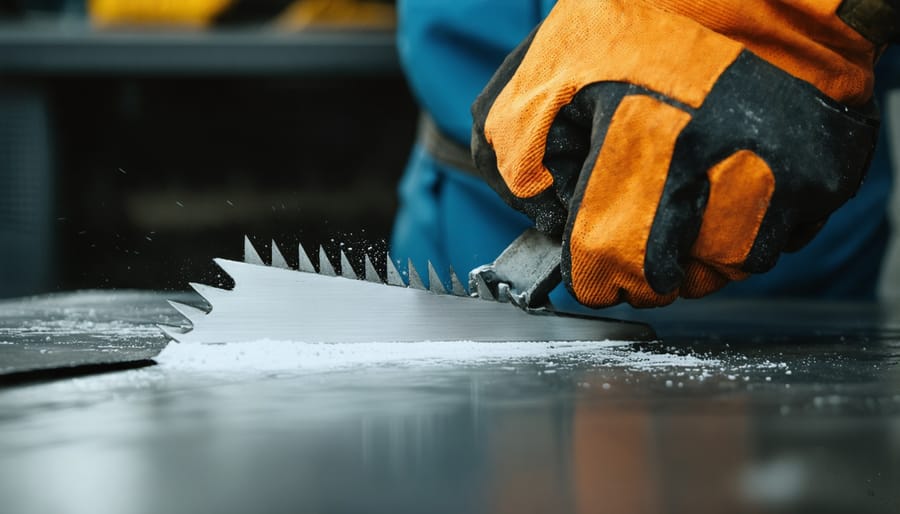
Blade Inspection and Cleaning
Before diving into blade sharpening, it’s crucial to properly inspect and clean your mower blade. Start by disconnecting the spark plug wire for safety – this prevents any accidental starts while you’re working. Carefully remove the blade, noting its orientation so you can reinstall it correctly later.
Examine the blade thoroughly for signs of damage like deep nicks, cracks, or severe bending. If you spot any major structural issues, it’s safer to replace the blade entirely. Minor nicks and dullness, however, are perfect candidates for manual sharpening. While you’re at it, this is an excellent opportunity to balance your mower blades for optimal performance.
Clean the blade using a wire brush or putty knife to remove built-up grass clippings, dirt, and rust. Pay special attention to both the cutting edge and the entire blade surface. Stubborn debris can be loosened with a mild degreaser, followed by thorough drying with a clean cloth.
Look for uneven wear patterns along the cutting edge – these indicate areas needing extra attention during sharpening. A properly maintained blade should have a consistent angle along its entire length. If you notice extreme wear on one side, this might suggest your mower deck needs leveling.
Remember, a clean blade not only makes sharpening easier but also helps you spot potential issues that might affect your mowing quality.
Manual Sharpening Techniques
File Sharpening Method
Using a file to sharpen your lawn mower blade is a time-tested method that delivers excellent results when done correctly. Begin by securing your blade in a vise with the cutting edge facing upward. Put on your safety glasses and work gloves before starting the sharpening process.
Take your flat file (ideally 10-12 inches long with a bastard cut) and position it at the same angle as the existing blade edge, typically between 30-45 degrees. To achieve optimal blade sharpness, maintain consistent pressure and angle throughout the filing process.
Push the file across the blade edge in one direction only – never use a back-and-forth motion as this can create an uneven edge. Count your strokes to ensure you’re applying the same number to both sides of the blade. Generally, 10-15 strokes per side should be sufficient for regular maintenance sharpening.
Pay special attention to any nicks or dents, working these areas a bit more until they’re smooth. After every few strokes, run your finger (with gloves on) along the back of the blade to feel for any burrs that may have formed. If you find any, carefully file them away.
Remember to maintain the blade’s original angle and avoid over-sharpening, which can weaken the blade. Test the edge by lightly running a piece of paper along it – a properly sharpened blade should slice through cleanly.
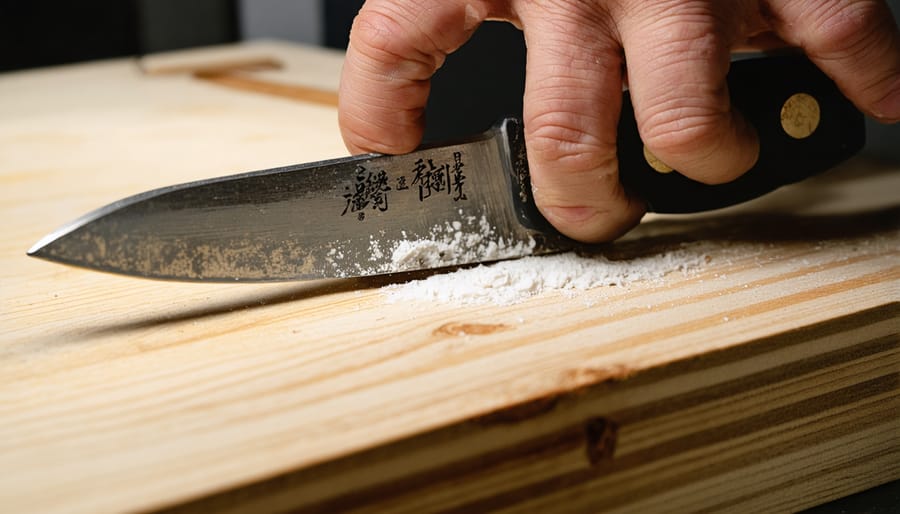
Sharpening Stone Technique
Using a sharpening stone is one of the most traditional and effective methods for maintaining your manual lawn mower blades. Start by securing your blade in a vise at a comfortable working height. Choose a medium-grit whetstone for initial sharpening, followed by a fine-grit stone for finishing.
Before beginning, soak your whetstone in water for about 10 minutes. This helps prevent the stone from becoming clogged with metal particles during sharpening. Hold the stone at the same angle as the blade’s existing edge, typically between 30 and 45 degrees. Using steady, controlled strokes, move the stone from the inner edge of the blade toward the cutting edge.
Apply moderate pressure and maintain consistent strokes in one direction only. After every few strokes, check your progress and ensure you’re maintaining an even angle. You’ll notice a burr (a thin wire edge) forming on the opposite side of the blade – this is a good sign that you’re making progress.
Once you’ve completed one side, flip the blade and repeat the process on the other edge. Finally, use your fine-grit stone with lighter pressure to achieve a smooth, sharp finish. Remember to wipe the blade clean after sharpening and test the edge carefully with a piece of paper – it should slice through cleanly.
For best results, sharpen your blades every 20-25 hours of mowing time, or whenever you notice declining cutting performance. This regular maintenance will extend your mower’s life and improve your lawn’s health.
Manual Blade Sharpening Tools
Manual blade sharpening tools come in various forms, each designed to make the sharpening process straightforward and effective. The most common tool is the mill file, a flat metal file with diagonal grooves that’s perfect for restoring a dull blade’s edge. When using a mill file, always work in one direction – pushing away from you – and maintain the original blade angle, typically around 30 degrees.
Another popular option is the sharpening stone, which comes in different grits. Start with a coarse grit (around 400) for badly damaged blades, then progress to a finer grit (1000 or higher) for finishing. These stones require proper lubrication with either water or honing oil to prevent metal particles from clogging the stone’s surface.
For those seeking more precision, blade sharpening guides are invaluable tools that help maintain the correct angle while sharpening. These guides typically clamp onto the blade and provide a consistent angle for your file or stone, ensuring even results across the entire cutting edge.
A basic sharpening kit should include:
– A quality 10-12 inch mill file
– A medium-grit sharpening stone
– Protective gloves
– Safety glasses
– A wire brush for cleaning
– A blade balancer
Remember to clean your tools after each use and store them in a dry place to prevent rust and maintain their effectiveness. Regular maintenance of your sharpening tools will ensure they remain reliable for years of lawn mower maintenance.
Maintenance and Care
Regular Maintenance Schedule
Regular blade maintenance is crucial for keeping your manual lawn mower performing at its best. As a general rule, inspect your mower blades every 8-10 hours of use or after mowing approximately 1-2 acres of lawn. If you frequently encounter tough grass, stones, or other debris, you may need to check more often.
For most home gardeners, this translates to checking blade sharpness every 2-3 weeks during the growing season. A simple test is to examine the grass after cutting – if you notice ragged or torn blade tips rather than clean cuts, it’s time to sharpen your blades.
Create a maintenance calendar that aligns with your mowing schedule. Spring is an excellent time for your first thorough blade inspection and sharpening of the year. Mid-season maintenance, typically in July, helps maintain optimal cutting performance during peak growing months. Plan for a final sharpening session in late fall before storing your mower for winter.
While inspecting your blades, look for signs of wear beyond dullness. Check for nicks, bends, or severe damage that might require blade replacement rather than just sharpening. Remember to clean your blades thoroughly before each sharpening session, as built-up grass and debris can affect the quality of your sharpening work and the overall cutting performance.
By following this regular maintenance schedule, you’ll extend the life of your mower blades and ensure a healthier, better-looking lawn throughout the season.
Preventing Blade Damage
Maintaining your mower blades properly not only helps extend your mower’s lifespan but also ensures a consistently clean cut for your lawn. To prevent blade damage during sharpening and regular use, start by inspecting your blades before each sharpening session. Remove any built-up grass clippings, dirt, or debris that could interfere with the sharpening process.
Always use steady, consistent strokes when manually sharpening your blades, avoiding excessive pressure that could create uneven wear or weak spots. Keep your sharpening angle consistent, typically between 30 to 45 degrees, depending on your mower’s specifications. This helps maintain the blade’s original cutting geometry and prevents structural weakening.
Store your mower in a dry place to prevent rust, which can compromise blade integrity. During mowing, watch out for hidden obstacles like rocks or tree roots that can nick or bend the blades. If you hear unusual sounds while mowing, stop immediately and check the blades for damage.
Regular cleaning after each use prevents moisture-related deterioration and helps you spot potential issues early. Consider keeping a spare set of blades on hand, allowing you to rotate them seasonally. This practice gives you time to properly maintain each set without rushing the sharpening process.
When storing your manual blade sharpener, keep it in a dry place and apply a light coat of oil to prevent rust, ensuring it’s ready for your next sharpening session.
Maintaining sharp mower blades is essential for a healthy, beautiful lawn, and using a manual blade sharpener is an effective, environmentally friendly way to achieve this. As we’ve explored throughout this guide, regular blade maintenance not only improves cutting performance but also promotes healthier grass growth and reduces the strain on your mower.
Remember that a well-maintained blade should be sharpened every 20-25 hours of mowing time, or when you notice signs of wear such as ragged grass tips or increased mowing resistance. By choosing manual sharpening methods, you’re not only saving money but also gaining more control over the sharpening process while reducing your carbon footprint.
The key to successful manual blade sharpening lies in following proper safety procedures, using the right tools, and maintaining a consistent angle while sharpening. Whether you choose a file, sharpening stone, or specialized manual sharpening tool, the most important factors are patience and attention to detail.
Make blade maintenance a regular part of your lawn care routine, and you’ll be rewarded with cleaner cuts, healthier grass, and a more efficient mowing experience. Don’t wait until your blade is severely damaged – regular maintenance is always easier than major repairs. With the techniques and tips we’ve covered, you’re well-equipped to keep your mower blades in prime condition throughout the growing season.
Happy mowing, and here’s to keeping your lawn looking its best with properly sharpened blades!
